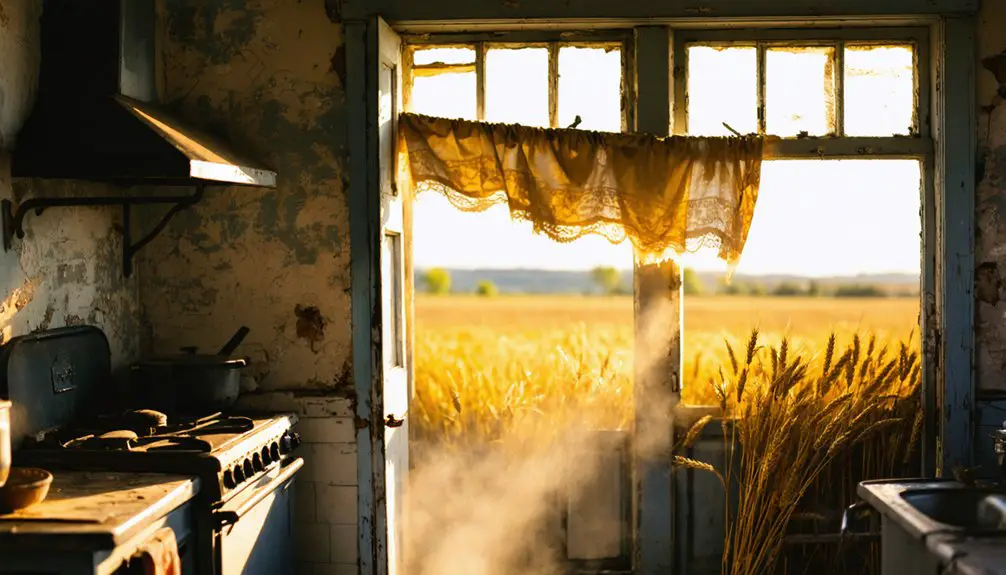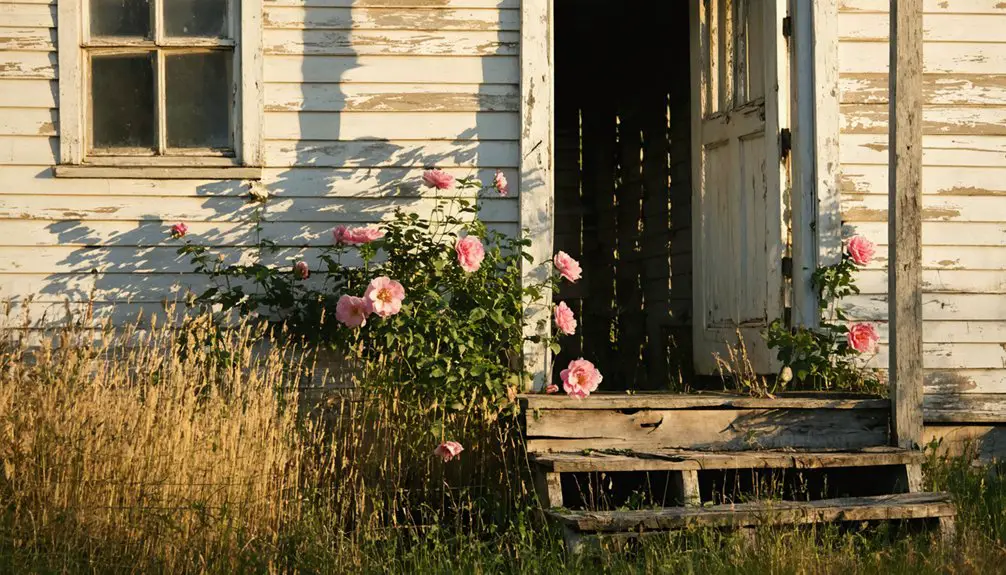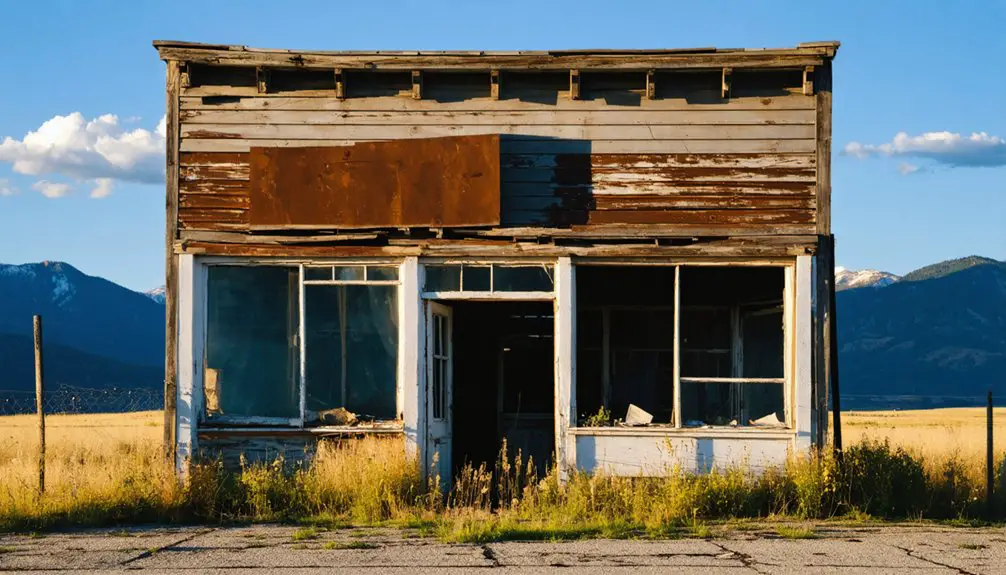You’ll find Sherman, Washington’s ghost town tucked away in Lincoln County, where a white pioneer church and cemetery mark what was once a thriving farming community. Founded in 1888 by George Sherman, the settlement prospered with three main streets, a post office, and blacksmith shop before declining as larger farming operations took over. Today, annual Memorial Day gatherings at the historic church grounds keep the town’s pioneering spirit alive, connecting past to present through cherished traditions.
Key Takeaways
- Sherman was founded in 1888 with three main streets and essential services to support an agricultural community near Govan, Washington.
- The town declined when new roads to larger cities emerged, wheat prices fell, and farming technology advanced, leading to rural depopulation.
- A historic white church and cemetery remain as landmarks, hosting annual Memorial Day gatherings to honor military service members.
- The collapsed schoolhouse and abandoned buildings serve as visible reminders of Sherman’s transformation from thriving community to ghost town.
- The site is accessible via gravel road off U.S. Highway 2, with public grounds open for exploration while respecting private property.
The Birth of a Prairie Town
When George Sherman platted the small prairie settlement of Sherman, Washington in August 1888, he laid the foundation for what would become a quintessential frontier farming community. As the town’s founder, postmaster, and prominent merchant, Sherman helped guide the settlement through its early challenges, establishing just three streets: Douglas, Lincoln, and Sherman. For historical accuracy, several disambiguation links were created to distinguish this Sherman from other locations sharing the name.
You’ll find that settlement challenges were met head-on with agricultural innovations and determination. The town quickly established essential services, including a post office, blacksmith shop, and sawmill to support the growing farming operations. Sherman served as the postmaster for fourteen years, overseeing mail operations for the growing community.
Located 56 miles northwest of Spokane, Sherman’s settlers capitalized on the fertile prairie soil during the region’s agricultural boom, though they faced harsh winters that tested their resolve. The promise of wheat farming drew pioneers primarily from Virginia, transforming the raw prairie into productive farmland.
Life in Early Sherman
You’d find the early Sherman farming families rising before dawn to tend livestock, plant or harvest wheat, and maintain their homesteads in the harsh prairie conditions.
Your social life would center around community gatherings at the church, where pioneer families shared news, celebrated holidays, and supported each other through the challenges of remote agricultural living.
If you were a Sherman resident in those early days, you’d participate in the strong mutual aid network that defined these eastern Washington settlements, where neighbors helped with barn-raisings, harvests, and other essential tasks of frontier life.
Children would walk each morning to the one-room schoolhouse that served as both an educational center and a symbol of the town’s commitment to learning.
The development of new roads connecting to larger cities like Spokane eventually led to Sherman’s decline as residents sought opportunities elsewhere.
Farming Family Daily Routines
Life in Sherman’s farming community revolved around a demanding daily schedule that began well before sunrise. You’d start your day by heading to the barn for essential livestock care – milking cows, feeding horses, and tending to chickens and pigs.
After checking your water sources, you’d inspect your fields and equipment for any overnight damage. Your success depended on mastering crop rotation and adapting to harsh weather conditions, especially during winter months. The devastating blizzard of 1889 tested farmers’ resilience when they struggled to protect their livestock in six feet of snow.
While you worked the fields with horse-drawn equipment, your family members tackled vital domestic tasks. Your wife would preserve food through canning and salting, while children helped with smaller animals and kitchen gardens.
Despite the grueling schedule, you’d pause for Sunday worship, using church gatherings to strengthen community bonds and share resources with neighboring farms.
Pioneer Homestead Social Activities
Despite the demanding nature of pioneer farm work, Sherman’s early settlers cultivated a vibrant social life centered around community gatherings and seasonal celebrations.
You’d find families congregating at community halls and pioneer buildings, where they’d share music, meals, and stories of their heritage. During harvest time and holidays like Halloween, Pioneer Farm buzzed with activity as neighbors joined together for festivities and games. Similar to the Washington Pioneer Association, these gatherings helped preserve the cultural identity of early Washington Territory settlers.
Local churches and schools served as essential social hubs where you could participate in religious services, potlucks, and educational activities. The community often enjoyed vintage trolley rides around the farm during special events.
Through community storytelling sessions, pioneers preserved their history and traditions while strengthening bonds. Seasonal celebrations often featured homemade treats, pumpkin patches, and cooperative work projects that doubled as social occasions, creating lasting connections among Sherman’s resilient homesteaders.
The White Church Legacy
Although Sherman has faded into ghost town status, its iconic white church stands as a symbol of the community’s enduring spirit.
You’ll find this bright white beacon, with its distinctive conical steeple, perched prominently above surrounding farmlands – a representation of its historical significance in the region. Similar to the Little White Church in Silvana, it served as a vibrant hub for community gatherings, hosting both Baptist and Presbyterian congregations, along with youth groups and literary societies. The church was instrumental in sustaining vibrant community life around 1900.
Today, while Sherman itself has largely disappeared, you can still visit the well-preserved church and its adjacent cemetery, where generations of farming families rest.
Memorial Day ceremonies continue at this sacred ground, where you’ll discover graves of early settlers, including a Civil War veteran, connecting you directly to America’s past through this enduring landmark.
Sacred Ground: Sherman Cemetery
Established in May 1893, Sherman Cemetery stands as a tribute to Lincoln County’s pioneer spirit, with C.T. Blackfan serving as its first president.
Founded in the late 19th century, Sherman Cemetery honors the pioneering heritage of Lincoln County under Blackfan’s inaugural leadership.
You’ll find this historic cemetery perched on a hill west of Sherman Road, nestled behind the Sherman Presbyterian Church and surrounded by rolling wheat fields. A welcoming memorial plaza entrance features a small fountain and benches.
This monument to historical preservation continues to serve the community, offering these notable features:
- Original 10.2-acre grounds marked by one of its earliest burials – the Blackfan baby in 1893
- Chain-link fenced grounds maintained by dedicated caretakers since 1912
- Annual Memorial Day celebrations that keep community traditions alive
- Diverse grave markers showcasing cemetery symbolism from ornate headstones to simple pre-engraved stones
The cemetery remains an active burial ground, preserving the legacy of Eastern Washington’s agricultural pioneers while connecting present-day residents to their roots.
Decline of a Farming Community

When Sherman first emerged in the 1880s during eastern Washington’s agricultural boom, its founders envisioned a thriving farming community supported by federal homesteading initiatives.
You’d have found pioneer families working the rolling wheat fields, building their lives around a modest but growing settlement complete with a church and schoolhouse.
But Sherman’s dream of economic sustainability wouldn’t last. As wheat prices plummeted and farming technology advanced, smaller family farms consolidated into larger operations, triggering rural depopulation.
The devastating 1889 blizzard dealt a harsh blow to livestock, while improved roads ironically hastened Sherman’s decline by making larger towns more accessible.
You can trace the community’s dissolution through its abandoned buildings – the collapsed schoolhouse stands as a poignant reminder of how quickly a farming town can fade when its economic foundation crumbles.
Memorial Day Traditions
Though Sherman now stands as a ghost town, you’ll find its heart still beats strongly each Memorial Day when farm families and pioneer descendants gather at the old church for their cherished annual tradition.
You can witness solemn ceremonies honoring military service members at the historic cemetery, where graves dating back to 1892 tell the stories of early settlers and veterans who shaped this community.
At these gatherings, you’ll experience how the preservation of Sherman’s Memorial Day traditions creates a living bridge between the town’s 19th-century origins and present-day participants who maintain their connection to this meaningful place.
Annual Community Gatherings
Despite Sherman’s status as a ghost town, its annual Memorial Day celebration at the Presbyterian Church stands as a symbol of enduring community bonds.
You’ll find local farm families and pioneer descendants gathering at the iconic white church with its conical steeple, demonstrating remarkable community resilience through their preservation efforts.
- The celebration centers on decorating graves with lilacs and American flags
- You can share home-cooked meals while connecting with fellow community members
- You’ll hear stories of Sherman’s heritage passed down through generations
- You’re welcome to participate in commemorative services that honor both ancestors and military veterans
This cultural continuity persists through active maintenance of the church grounds, including modern additions like a wheelchair ramp, ensuring accessibility for all who wish to participate in this cherished tradition.
Military Service Recognition
Sherman’s deep military heritage echoes through its Memorial Day traditions, rooted in the town’s founding by Civil War veterans from Virginia. You’ll find these veteran celebrations continue annually at the surviving church, where farm families and pioneer descendants gather to honor those who served.
The town’s military legacy lives on through various memorials, including the GAR hall built in 1893 and the carefully maintained cemetery where a notable Civil War veteran rests.
The Sherman Swastika Ladies Club, established in 1912, played an essential role in preserving these military memorials through their dedicated upkeep of the grounds.
Despite Sherman now being a ghost town, you can still witness the community’s enduring respect for its military heritage during Memorial Day services, where they pay tribute to service members from Sherman and surrounding areas.
Pioneer Family Remembrance
Memorial Day traditions in Sherman center on two cherished gatherings: the historic church service and cemetery visitations, where pioneer family descendants unite to honor their agricultural heritage.
Through pioneer storytelling and ancestral connections, you’ll discover how these families preserve their legacy while strengthening intergenerational bonds.
- Descendants of original settlers share oral histories detailing the hardships and triumphs of establishing farms in the 1880s.
- The preserved church and cemetery serve as focal points for commemorative ceremonies.
- Family stories, including tales of spectral visitations, enrich Sherman’s local lore.
- Community members maintain gravesites and records, ensuring the preservation of pioneer family lineages.
You’ll find these gatherings reinforce Sherman’s identity, despite its ghost town status, through continued family presence and shared agricultural roots.
Finding Sherman Today
Located approximately 15 minutes northeast of Govan off U.S. Highway 2, Sherman awaits ghost town exploration enthusiasts.
A forgotten ghost town beckons adventurous souls to explore its remnants just minutes from Highway 2 near Govan.
You’ll need to shift from the paved highway near Creston onto a gravel road, following North Mt. View Road through hilly terrain until you reach the historic site.
The well-preserved white church with its striking stained glass window serves as your primary landmark, standing proudly against a backdrop of golden wheat fields.
Behind it, you’ll find the 1892 cemetery enclosed by chain-link fencing – a tribute to historic preservation efforts.
While most structures have vanished, scattered ruins and the schoolhouse remain visible across the open landscape.
You’re free to explore the public grounds, but remember to respect both the cemetery and any adjacent private property during your visit.
Echoes of the Homesteading Era

When homesteaders first arrived in the Sherman area around 1880, they joined a sweeping migration that transformed eastern Washington’s landscape.
You’ll find their pioneering spirit echoed in the remaining structures and stories that detail the agricultural changes they faced.
The region’s homesteading challenges shaped daily life through:
- Wheat farming that demanded countless hours of backbreaking labor
- Severe weather events, like the devastating 1889 blizzard that buried hopes under six feet of snow
- The essential community bonds forged through shared church services and school activities
- The gradual shift toward mechanization that forever changed traditional family farming
Today, Sherman’s preserved church and cemetery stand as silent witnesses to these determined settlers who carved out their independence in eastern Washington’s untamed frontier.
Frequently Asked Questions
Are There Any Known Paranormal Activities Reported at Sherman’s Church or Cemetery?
You won’t find documented ghost sightings or spectral encounters at Sherman’s church or cemetery. While it’s a classic ghost town setting, there’s no verified paranormal evidence from either location.
What Happened to the Original Residents and Their Descendants?
You’ll find the original families moved away due to falling farm profits, while their descendants scattered across wider communities but maintain connections through annual Memorial Day gatherings and cemetery preservation activities.
Can Visitors Enter the Church Building Today?
You can explore inside this historic church today – just sign the visitor register when you enter. You’ll find welcoming accessibility features like a wheelchair ramp and well-preserved historical displays.
Were There Any Notable Crimes or Incidents in Sherman’s History?
You won’t find any documented crimes or notable historical incidents in Sherman’s records. Unlike other ghost towns in the region, Sherman maintained a peaceful, church-centered farming community throughout its existence.
How Many Buildings Were Originally Constructed in Sherman During Its Peak?
Time has erased the exact count, but you’d find a handful of abandoned structures during Sherman’s peak – likely 10-15 buildings including shops, homes, sawmill, church, and schoolhouse.
References
- https://www.inlander.com/culture/sherman-wash-tucked-amid-rolling-fields-is-the-well-kept-remnant-of-a-town-that-began-to-decline-shortly-after-its-founding-in-the-1880s-28851253
- https://en.wikipedia.org/wiki/Sherman
- https://stateofwatourism.com/ghost-towns-of-washington-state/
- https://everydayspokane.com/ghost-towns-in-washington-state/
- https://www.youtube.com/watch?v=qk5GmvLhefg
- https://www.aol.com/ghost-towns-sit-abandoned-across-204352655.html
- https://photos4thepeeps.wordpress.com/2009/12/22/eastern-washington-ghost-towns-part-3-shermanwa/
- https://cms.agr.wa.gov/WSDAKentico/Imported/WashingtonsCentennialFarms-Color-Web.pdf
- https://wapioneers.com
- https://www.whidbeylocal.com/article/view/2678/2021/10/time-to-visit-sherman-s-pioneer-farm-one-last-time



